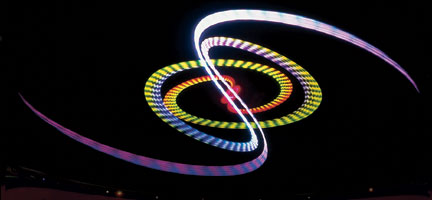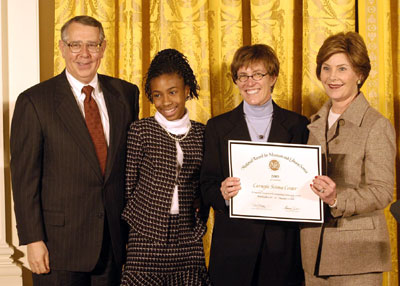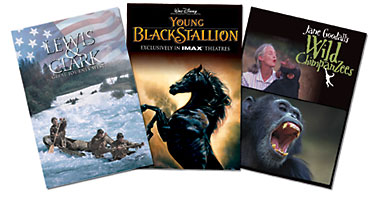Escape into the Laser Landscape
Enjoy an Evening Laser Show at Henry Buhl, Jr. Planetarium

“It’s not quite the theater
and not really the movies,” says “Laserist” Greg
Madden of the Henry Buhl Jr., Planetarium and Observatory. “Laser
shows are hard to define…you don't really see
a show, you experience it. People leave saying, ‘How
did you do that?’”
So how do they do that?
Well, like any good magician, Madden is hesitant
to reveal his methods, but he did
divulge a few secrets.
Each show begins with the soundtrack.
Madden—who
changes shows every three to four months to keep
things fresh—conducts market research to see
what’s
hot (Brittany and Christina were hot, hot, hot
last year; now they’re not, not, not) and then
selects songs from a catalog offered by LFI International,
a laser entertainment producer. (LFI pays the music
licensing fees, and Buhl Planetarium pays LFI a
user’s
fee.) Madden, who operates the laser equipment,
and Joe “Jupiter” Morgan and Sam “Saturn” Barna,
the two star pilots who run the planetarium equipment,
listen to the new soundtrack, take notes, and begin
kicking around ideas. The crew then embarks on
at least three hours of rehearsal—where a song
could be played up to 14 times—to work out
ideas and effects.
To make every show unique, no “script” is
created. This approach also provides the crew
the opportunity to play off the audience—whether
it's a quiet group of seven, a boisterous group
of college kids,
or a true devotee seeing the show for the 47th
time.
At an estimated 420 shows a year, these
guys must be the most creative people in the galaxy.
So how does one become a laserist? According
to Madden, you have to know the right person
at the
right time. “There’s
no Laser Show University,” he says with
a laugh. Madden became a star pilot “by
accident” when
he began volunteering at the old Buhl Planetarium
in 1983. He now trains star pilots.
“
Laser show operators are born, not made,” Madden
says. “It's very intuitive. You either
have it or you don't, and you don't know that
until you try
it.”
A laserist also has to be a technician
as there’s
no nearby Quicky-Lube to take laser equipment
that’s
knocking and pinging. Most of Madden’s
knowledge of the systems—covering lasers,
fiber-optics, and audio—came from calling
the manufacturer when things went wrong and
listening to them explain
how to fix the problem. Equipment includes
the Lumisphere, a twin-laser, graphics projection
system (the only
one in use on the planet) that reflects light
and color onto the full-dome theater, and the
Digistar, a computer-driven
projection system that produces digital, 3D
stars and a range of planetarium effects.
In
February, Buhl Planetarium debuted a new line-up
of shows including the return of laser
Led Zeppelin;
Laser Laughs, a new family show; a revamped
80s show; and a Grunge show. But don’t
worry, Midnight Floyd—a Pittsburgh staple
for 20 years that draws a crowd ranging in
age from 12 to 60-plus—is
still on the roster. "There will always
be a Midnight Floyd," says Madden. A discount
is available to anyone wanting to see more
than one show in an evening.
“
Ninety percent of the audience show up based
on word of mouth,” says Madden. “Whether
we have three people or 300 in the audience,
they pay for a
good show and that's what we give them.”
Carnegie Science Center Honored
at the White House

Seen
from left to right: Howard J. Bruschi, Chairman of
the Science Center’s Board; Mareena Woodbury-Moore,
Youth Explorer and K-6 Mentor; Joanna E. Haas, Henry
Buhl, Jr., Director of Carnegie Science Center; and
First Lady Laura Bush.
At
the White House on January 22, 2004, First Lady
Laura Bush
presented Carnegie Science Center with the National
Museum Service Award
for its outstanding community educational programs
in 2003. The awards were given to three libraries
and three museums from across the country. Each
institution was honored by the Institute of Museum
and Library
Services
(IMLS) for demonstrating national leadership through
its educational and public service programs. Each
organization also receives $10,000.
Representing
Carnegie Science Center were Ellsworth Brown, president
of Carnegie Museums of Pittsburgh;
Suzy Broadhurst, chairman of the board of Carnegie
Museums of Pittsburgh; Joanna E. Haas, the Henry
Buhl, Jr., director of Carnegie Science Center;
Howard J.
Bruschi, chairman of the Science Center’s
board; and Ron Baillie, director of education
at the Science
Center.
Also attending were Evan Frazier, executive
director of Hill House Association and a member
of Carnegie
Science Center’s board, who has been involved
in community-based activities with PNC Bank;
and Mareena Woodbury-Moore, youth explorer and
K-6 Mentor at the
Science Center. Mareena was in the first class
of Mission Discovery in Pittsburgh’s Hill
District, and after 8th grade became the first
student to make the
transition to the on-site program for high school
students, Science in Your Neighborhood.
“
Carnegie Science Center is honored to be among the
prestigious field of
winners of the 2003 National Awards for Museum
and Library Service,” said President
Ellsworth Brown. “The
Science Center believes that all residents
need to be empowered in the fields of science
and technology
in order to embrace the opportunities of an
amazing future.”
Laura Bush, a passionate
advocate for educational opportunities at the
nation’s libraries and museums, said, “The
museums and libraries we honor today have developed
innovative partnerships and programs for learners
of all ages, from babies to baby boomers to
seniors. Thanks
to these museums and libraries, Americans of
all ages are discovering the greatest lesson
of all, and that
is learning is lifelong.” She also noted
that President George Bush has proposed a 14
percent increase
in funding for IMLS in the 2005 budget, to
support lifelong learning, which is “the
ultimate goal of museums and libraries today.”
Profiles
of the winning organizations and photographs
of the award
representatives are available at www.imls.gov/whatsnew/.

Racing into the Rangos Omnimax Theater March 12
NASCAR 3D: The IMAX Experience
Experience NASCAR like
never before through the magic of IMAX 3D technology.
With NASCAR 3D: The IMAX Experience,
you'll be transported into the driver's seat of
North America's most popular spectator sport.
NASCAR
3D: The IMAX Experience goes behind the scenes
of the races to uncover the science, technology
and teamwork that make up this preeminent sport.
Meet the drivers as they compete for the coveted checkered
flag.
Discover the technology and underlying physics
that
drivers depend on, and meet the millions of passionate
fans who are devoted to this exciting sport.
For
more information on show times, titles, and prices,
visit www.CarnegieScienceCenter.org or
call 412.237.3400.
On the Big Screen
Don’t miss these OMNIMAX® Movies!

There’s still time to catch three “big” movies
showing at Carnegie Science Center’s Rangos Omnimax
Theater. Lewis & Clark: Great Journey West and
Jane Goodall's Wild Chimpanzees continue through June;
The Young Black Stallion rides into the sunset March
19.
Lewis & Clark chronicles the adventures of the
explorers dispatched by President Thomas Jefferson
in 1803 (led by Meriwether Lewis and William Clark)
to find a water passageway to the Pacific Ocean.
Meticulous recreations bring to life this most compelling
and
heroic historic adventure.
Join the world's most
famous female scientist in Tanzania's Gombe Stream
National Park in Jane Goodall's
Wild Chimpanzees. Four decades of Goodall’s research into chimpanzee
behavior are explored with both contemporary and
archival footage. Although Goodall has appeared
numerous times
on National Geographic specials, this is the first
time her work has appeared on the giant screen.
Young
Black Stallion, a prequel to the 1979 classic
and the first dramatic feature made specifically
for the giant screen by Walt Disney Pictures,
relates the
story of a horse’s adventures with a young
girl named Neera. Separated from her family in
the Arabia
desert during WWII, Neera befriends a wild colt
she names Shetan. But once reunited with her family,
Neera
remains haunted by images of the “lost horse
of the desert.”
Astronomy Weekend
April 3-4, 2004
By
John G. Radzilowicz, director of the Henry Buhl,
Jr. Planetarium
and Observatory On Saturday and Sunday, April 3-4, 2004 visitors can
join the staff of Carnegie Science Center’s Henry
Buhl, Jr. Planetarium & Observatory along with
members of the Amateur Astronomers Association of Pittsburgh
for a two-day celebration of Astronomy and Space Science!
Pittsburgh’s
astronomical weekend grew out of a grass roots “Astronomy
Day” event that
started in 1973. For 30 years now, professional and
amateur astronomers have joined forces to share the
joy of astronomy with as many people as possible
during these special events. During these astronomical
festivals,
hundreds of thousands of people around the world
will have an opportunity to see firsthand what has
so many
astronomers excited. Astronomy clubs, science centers,
observatories, planetariums, universities, and nature
centers worldwide host gatherings and activities
to acquaint their visitors with local astronomical
resources
and facilities—all to help bring the universe
a little closer.
Astronomical celebrations will take
place at hundreds of sites across the United States.
Internationally,
England, Canada, New Zealand, Finland, Sweden,
the Philippines, Argentina, Malaysia, New Guinea, and
many other countries are hosting activities. Each
location
plans and executes special events that work best
for their local community.
So, what can visitors
expect? At Carnegie Science Center, visitors will
be able to fly to the far
reaches of
the Cosmos in the Planetarium, launch model rockets
along the Ohio River, study the Sun, Moon, and
stars from the rooftop Observatory and get a
close-up look
at meteorites and Moon rocks. They will learn
about the latest news from Mars and explore the universe
around us through shows, lectures, workshops,
and
lots of hands-on fun. Activities are geared for
all ages
and interest levels.
Whether you’re interested
in learning how to find your way among the
stars, checking out the latest
and greatest telescopes, hearing about the
latest astronomical news, or exploring life aboard
the
International Space
Station, this weekend is for you!
Back to Contents |